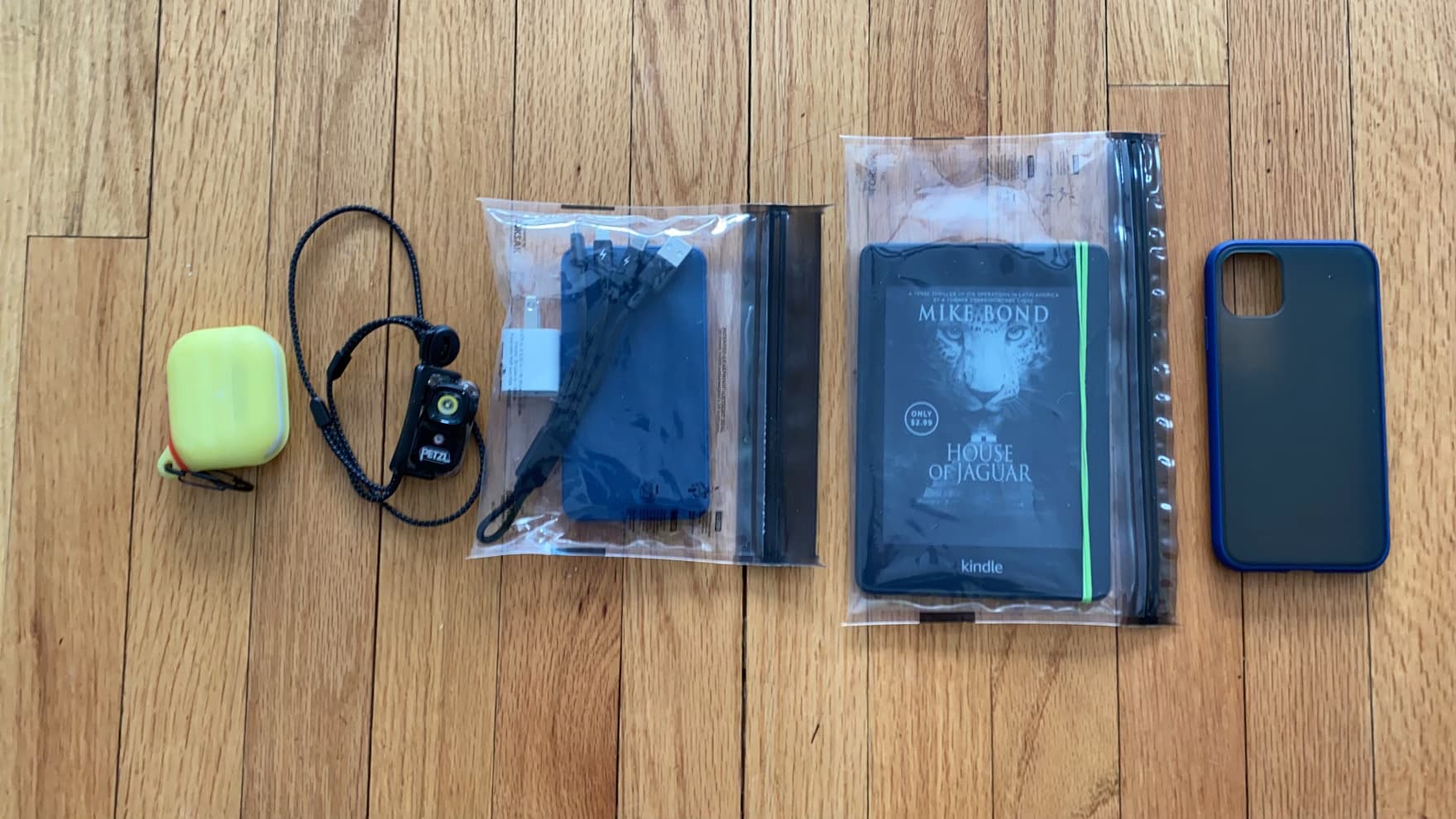
This is all of the gear I will be taking on my hike. Well, everything except my backpack and the clothes I’ll wear day 1. Swede is in the picture for scale only - she is not a hiking dog!
When you are walking long distances, especially with any elevation change, keeping the total weight of your gear as low as possible is a game changer. Ounces make pounds so you weigh EVERYTHING and make choices. Comfort items generally don’t make it. My splurge items are my Kindle and AirPods :)
Backpackers typically categorize their gear into 3 groups:
- Worn Weight - everything you anticipate wearing on the first day of your hike, including everything from shoes to hiking poles. This will decrease in summer when the winter gear gets sent back home.
- Consumables - Food, water, cooking gas. I will carry a max of 5 days worth of food at a time, and sometimes only a couple of days depending on access to towns along the way. A days worth of food for me is typically 1.5# (ish).
- Base weight - Everything else on and in your backpack, including your backpack. My goal for this trip was to get my base weight as close to 15# as possible.
Gear
Worn Weight

Weather in the Georgia mountains can be a crap shoot in March. I’m assuming the daytime temps will be in the 30’s - 50’s with night time temps in the 20’s and possible teens.
My go to clothes are Kuhl hiking pants and Smartwool shirts. Footwear will make or break you - I go with Darn Tough socks, Injinji sock liners, and Arcteryx Boots. I will probably go through 3 pair of boots on the trip.
Hiking poles are a must to save your knees and give your hands something to do all day.
The Big Four

The ‘Big Four’ are tent, sleeping pad, sleeping quilt, and backpack. It’s where you can shave off a lot of weight by buying ultra light gear. My current backpack (Osprey EJA 48) weighs over 6# less than the backpack I started with many years ago.
I just got a sleeping quilt - a lighter and comfier sleeping bag compared to mummy sleeping bags. It weighs a full pound less than my mummy bag. How well this works is TBD.
Rain Gear

Rain, snow, sleet, wind or whatever awful weather the day brings, your raincoat is critical. I am taking rain pants but they are on the short list to get rid of depending on the weather. The rain kilt on the other hand, that doubles as a ground cloth. Rain kilt? Yes, it’s a real thing. Dork factor is off the charts when wearing it…
Water

Water is usually plentiful along the AT, especially in the spring/early summer so I wont carry more than 2 quarts. Most places where I camp will have access to water of some sort. My water filter (Sawyer Squeeze) is super small and will quickly filter water. I also take Aqua Mira tablets for some of the mirkier water or high use areas. My go to for a water bottle is something light and easy to drink out of - usually a Smartwater bottle or Dasani.
Food

Backpacking food always tastes great mainly because you are so hungry. Mashed potatoes, tuna in packs, and dehydrated noodles are a staple. I usually added an assortment of freeze dried vegetable to whatever I’m making. But you don’t go backpacking for the food :). I boil water with my trusty MSR Pocket Rocket in a Toaks 750 ml titanium pot. I have another mug for coffee/tea/hot chocolate and a spoon. It’s simple and works great, is extremely light, and is compact.
Toiletries

Like it or not, when you backpack, you have to know how to crap in the woods, tundra, pit toilet, etc. Its what everyone asks about but really not much of an issue. Leave No Trace principles are what you live by to keep the wild wild. While some of the AT has ‘facilities’ of some sort in the higher use areas, you never know when nature calls. My toiletries have changed over the years to reduce toilet paper quantity and make the process easier and cleaner. If you’re not a backpacker, all of these items will seem odd at best. Don’t knock it till you’ve tried it!
- Outdoor Bidet - a 150 ml lab bottle with a spout. It takes some practice to perfect.
- The Kula cloth - It is used as a pee cloth. It hangs on the outside of your pack.
- PStyle - a female urination device. You try a lot of things that don’t work well and I was surprised how well this worked. There are advantages to not taking your backpack off to pee as well as not peeing all over your hiking boots.
- The Deuce of Spades trowel - This is another new addition. It weighs .4 oz and needs some practice to use. Yes, I did dig some cat holes in the backyard last summer so :).
- Hand sanitizer (not pictured) - That, along with Dr. Bonners camp soap are used frequently. Backpackers knew how to sanitize their hands long before COVID!
Electronics

My iPhone will serve as communication device, GPS trail map (using the Guthook app), and camera. I’m taking a 10000 mAh power bank to charge my phone and AirPods. The Kindle won’t need to be charged on the trail. I like hiking without headphones/music/podcasts/audiobooks, but they sure do help when the miles are long and your feet are not feeling it.
First Aid/Medical

First Aid kit consists of blister pads, Antibiotic cream, a needle, alcohol wipes, and the multi-purpose Leuko tape. Medications are anti-diarrheal, Advil, Aleve, sleep aids. Toothbrush, toothpaste, anti-chafe, and the extremely important ear plugs.